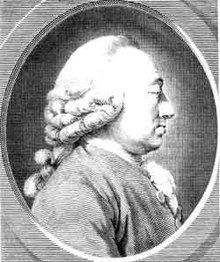Charles Bonnet
| Charles Bonnet | |
|---|---|
 |
|
| Born |
13 March 1720 Geneva, Republic of Geneva |
| Died | 20 May 1793 (aged 73) Genthod near Geneva, Republic of Geneva |
| Citizenship | Citizen of the Republic of Geneva |
| Fields | Naturalist |
| Influences | Gottfried Wilhelm Leibniz |
Charles Bonnet (French: [bɔnɛ]; 13 March 1720 – 20 May 1793), Genevannaturalist and philosophical writer, was born at Geneva, of a French family driven into the region by the religious persecution in the 16th century.
Bonnet's life was uneventful. He seems never to have left the Geneva region, nor does he appear to have taken any part in public affairs except for the period between 1752 and 1768, during which he was a member of the council of the republic. The last twenty five years of his life he spent quietly in the country, at Genthod, near Geneva, where he died after a long and painful illness on 20 May 1793. His wife was a lady of the family of De la Rive. They had no children, but Madame Bonnet's nephew, the celebrated Horace-Bénédict de Saussure, was brought up as their son.
He made law his profession, but his favourite pursuit was the study of natural science. The account of the ant-lion in Noël-Antoine Pluche's Spectacle de la nature, which he read in his sixteenth year, turned his attention to insect life. He procured RAF de Réaumur's work on insects, and with the help of live specimens succeeded in adding many observations to those of Réaumur and Pluche. In 1740, Bonnet communicated to the Academy of Sciences a paper containing a series of experiments establishing what is now termed parthenogenesis in aphids or tree-lice, which obtained for him the honour of being admitted a corresponding member of the academy. During that year he had been in correspondence with his uncle Abraham Trembley who had recently discovered the Hydra. This little creature became the hit of all the salons across Europe once philosophers and natural scientists saw its amazing regenerative capabilities. In 1741, Bonnet began to study reproduction by fusion and the regeneration of lost parts in the freshwater hydra and other animals; and in the following year he discovered that the respiration of caterpillars and butterflies is performed by pores, to which the name of stigmata (or spiracles) has since been given. In 1743, he was admitted a fellow of the Royal Society; and in the same year he became a doctor of laws—his last act in connection with a profession which had ever been distasteful to him. In 1753, he was elected a foreign member of the Royal Swedish Academy of Sciences, and on 15 December 1769 a foreign member of the Royal Danish Academy of Sciences and Letters.
...
Wikipedia
